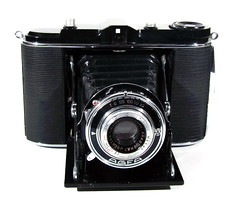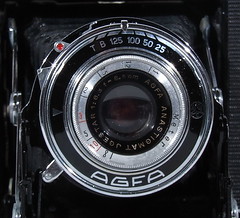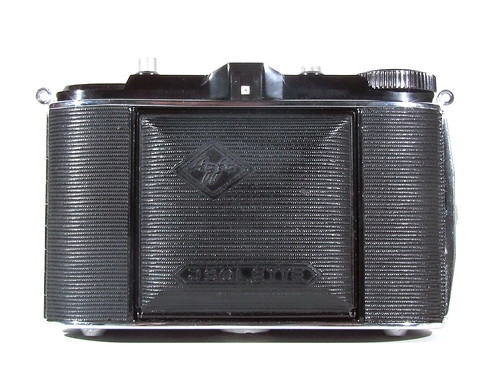Difference between revisions of "Isolette"
m (Commented out the model list; this article only covers the late 1930s camera.) |
(Rewrote a bit; took out most references to the Jsolette/Isolette thing. Adjusted dates to agree with McKeown. Added cats) |
||
| Line 1: | Line 1: | ||
| − | The ''' | + | The '''Isolette''' (embossed in the leatherette as <small>'''''J''SOLETTE'''</small>)<ref>The name is written as Jsolette simply because the capital "I" resembles a "J" in German typography of the time. The embossing on the camera was changed to a modern "I" in 1937. See: [http://www.kindredroots.com/What/germanletters/germanletters_caps.htm Old German Letters]</ref> is a horizontal-[[folding]] camera for twelve 6×6 cm (2¼-inch square) pictures (or sixteen 4.5×6 cm (2¼×1⅝ inch) pictures, with the first model of the camera) on [[120 film]]. It was made by [[Agfa]] Kamerawerk AG, Munich, Germany, from 1938.<ref name=McK>{{McKeown12}} p25.</ref> |
| − | There are two distinct models of the first | + | |
| + | It first came on the market as the '''Iso''r''ette''' (again, appearing as <small>''J''SORETTE</small> on the camera), but the name was changed to '''Isolette''' within a year. | ||
| + | |||
| + | There are two distinct models of the first Isolette series: the early one (before and during the Second World War) and the post-War one. | ||
<!--Commenting out this whole section. This article only covers the late-thirties models, so doesn't need a model list up to the 50's --~~~~ | <!--Commenting out this whole section. This article only covers the late-thirties models, so doesn't need a model list up to the 50's --~~~~ | ||
| Line 17: | Line 20: | ||
| − | == | + | ==Isolette (1938-42)== |
{{Flickr_image | {{Flickr_image | ||
|image_source=http://www.flickr.com/photos/raulm/3984687578/in/pool-camerawiki | |image_source=http://www.flickr.com/photos/raulm/3984687578/in/pool-camerawiki | ||
|image= http://farm4.static.flickr.com/3470/3984687578_bc7446c4e7.jpg | |image= http://farm4.static.flickr.com/3470/3984687578_bc7446c4e7.jpg | ||
|image_align= right | |image_align= right | ||
| − | |image_text= | + | |image_text= First model Isolette. |
|image_by= Raúl Sá Dantas | |image_by= Raúl Sá Dantas | ||
|image_rights= with permission | |image_rights= with permission | ||
}} | }} | ||
| − | This | + | This first model was a dual format camera: by using 2 internal masks it could be changed from the 6x6cm format to the 4.5x6cm format. There is also a mask for the viewfinder. |
| − | This model was called | + | One of the distinctive features is the top housing made of a plastic called "Trolitan"; the post-War camera has a cast aluminium top housing. This camera also has loops to attach a strap, the only version of the Isolette to have these. |
| + | Different lens and shutter combinations were available, allowing a wide range of levels of specification. This model was called the "Soldatenkamera" (soldier's camera) in Germany during the War. | ||
| + | |||
| − | + | * Year of release: 1938<ref name=McK></ref> | |
| − | + | * Film Format: 12 exp. 6x6 or 16 exp. 4.5x6 on [[120 film|120 type rollfilm]]. | |
| − | + | * Shutter: [[Vario]], [[Pronto]], [[Prontor|Prontor II]], [[Compur]] or [[Compur-Rapid]]. | |
| + | * Lens: Igestar 8.5cm f/6.3, Apotar 8.5cm f/4.5 or Solinar 8.5cm f/4.5. | ||
| + | * Viewfinder: reverse-Galilean viewfinder | ||
| − | + | The earliest cameras have Vario shutters which are not labelled as such. | |
| − | |||
| − | |||
| − | |||
| − | |||
| − | |||
| − | |||
| − | |||
{{br}} | {{br}} | ||
{|class=plainlinks align="center" | {|class=plainlinks align="center" | ||
| − | + | | | |
{{Flickr_image | {{Flickr_image | ||
|image_source= http://www.flickr.com/photos/s-demir/5351076559/in/pool-camerawiki/ | |image_source= http://www.flickr.com/photos/s-demir/5351076559/in/pool-camerawiki/ | ||
| − | |image= http://farm6.static.flickr.com/5121/5351076559_38e7b8307e_m.jpg | + | |image= http://farm6.static.flickr.com/5121/5351076559_38e7b8307e_m.jpg |
|image_align= | |image_align= | ||
|image_text= | |image_text= | ||
| Line 55: | Line 55: | ||
|image_rights= | |image_rights= | ||
}} | }} | ||
| − | + | | | |
{{Flickr_image | {{Flickr_image | ||
| − | |image_source= http://www.flickr.com/photos/s-demir/ | + | |image_source= http://www.flickr.com/photos/s-demir/5351689218/in/pool-camerawiki/ |
| − | |image= http://farm6.static.flickr.com/ | + | |image= http://farm6.static.flickr.com/5206/5351689218_2c26a5db61_m.jpg |
| − | |image_align= | + | |image_align= |
|image_text= | |image_text= | ||
|image_by= | |image_by= | ||
|image_rights= | |image_rights= | ||
}} | }} | ||
| − | + | | | |
{{Flickr_image | {{Flickr_image | ||
| − | |image_source= http://www.flickr.com/photos/s-demir/ | + | |image_source= http://www.flickr.com/photos/s-demir/5351079367/in/pool-camerawiki/ |
| − | |image= http://farm6.static.flickr.com/ | + | |image= http://farm6.static.flickr.com/5284/5351079367_3a19f86223.jpg |
| − | |image_align= | + | |image_align= |
|image_text= | |image_text= | ||
|image_by= | |image_by= | ||
| − | |image_rights= | + | |image_rights= |
}} | }} | ||
|- | |- | ||
| − | |colspan=3 align="center"| | + | |colspan=3 align="center"| Isolette, first model, about 1938. |
| − | <small>Images by Süleyman Demir | + | <small>Images by [[:Category:Image by Süleyman Demir|Süleyman Demir]]</small> {{with permission}} |
|} | |} | ||
| − | == | + | ==Isolette (1945-50)== |
{{Flickr_image | {{Flickr_image | ||
|image_source=http://www.flickr.com/photos/29504544@N08/5274371955/in/pool-camerawiki | |image_source=http://www.flickr.com/photos/29504544@N08/5274371955/in/pool-camerawiki | ||
|image= http://farm6.static.flickr.com/5002/5274371955_2ba455deb5.jpg | |image= http://farm6.static.flickr.com/5002/5274371955_2ba455deb5.jpg | ||
|image_align= right | |image_align= right | ||
| − | |image_text= | + | |image_text= Post-War Isolette |
|image_by=Hans Kerensky | |image_by=Hans Kerensky | ||
|image_rights= with permission | |image_rights= with permission | ||
}} | }} | ||
| − | The late model was made from 1945 till 1950 | + | The late model was made from 1945 till 1950. The top housing of this model is cast from Hydronalium (Nüral: an aluminium alloy). There were different lens/shutter combinations possible. Other changes from the early model are to one film format only (6x6) and the addition of an accessory shoe (above the viewfinder). |
* Year of release: 1945 | * Year of release: 1945 | ||
| − | * Film Format: 12 exp. 6x6 on [[120 film | + | * Film Format: 12 exp. 6x6 on [[120 film]]. |
* Shutter: [[Prontor]], Prontor-S or [[Compur-Rapid]]. | * Shutter: [[Prontor]], Prontor-S or [[Compur-Rapid]]. | ||
| − | * Lens: Apotar 4.5 | + | * Lens: Apotar 8.5cm f/4.5 or Solinar 8.5cm f/4.5. |
* Double exposure prevention. | * Double exposure prevention. | ||
| − | * Viewfinder: | + | * Viewfinder: reverse-Galilean viewfinder |
| − | + | ||
| + | |||
| + | ==Succeeding models== | ||
| + | After 1950, several different models of the Isolette were made at the same time, with different levels of specification: | ||
| + | * the [[Agfa Isolette I|Isolette I]] | ||
| + | * the [[Agfa Isolette II|Isolette II]] | ||
| + | * the [[Agfa Isolette III|Isolette III]] | ||
| + | * the [[Agfa Isolette V|Isolette V]] | ||
| + | * the [[Super Isolette]] | ||
| + | * the [[Isolette L]] | ||
| + | |||
| − | |||
| − | ==Notes | + | ==Notes== |
<references/> | <references/> | ||
| − | + | ||
| − | |||
| − | |||
== Links == | == Links == | ||
| Line 110: | Line 117: | ||
* [http://www.ken.lyndrup.dk/Engelsk/Agfa/Isorette%20E.htm in Ken Lyndrup's website] | * [http://www.ken.lyndrup.dk/Engelsk/Agfa/Isorette%20E.htm in Ken Lyndrup's website] | ||
| − | [[Category:Agfa| | + | [[Category: Agfa|Isolette]] |
| − | [[Category:120 film]] | + | [[Category: 120 film]] |
| − | [[Category:German 6x6 viewfinder folding]] | + | [[Category: German 6x6 viewfinder folding]] |
| + | [[Category: German 4.5x6 viewfinder folding]] | ||
| + | [[Category: Image by Süleyman Demir]] | ||
Revision as of 20:02, 31 October 2011
The Isolette (embossed in the leatherette as JSOLETTE)[1] is a horizontal-folding camera for twelve 6×6 cm (2¼-inch square) pictures (or sixteen 4.5×6 cm (2¼×1⅝ inch) pictures, with the first model of the camera) on 120 film. It was made by Agfa Kamerawerk AG, Munich, Germany, from 1938.[2]
It first came on the market as the Isorette (again, appearing as JSORETTE on the camera), but the name was changed to Isolette within a year.
There are two distinct models of the first Isolette series: the early one (before and during the Second World War) and the post-War one.
Isolette (1938-42)
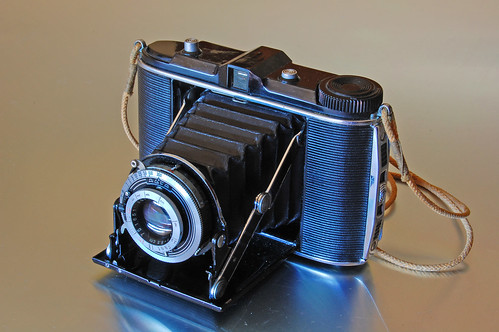
|
| First model Isolette. image by Raúl Sá Dantas (Image rights) |
This first model was a dual format camera: by using 2 internal masks it could be changed from the 6x6cm format to the 4.5x6cm format. There is also a mask for the viewfinder.
One of the distinctive features is the top housing made of a plastic called "Trolitan"; the post-War camera has a cast aluminium top housing. This camera also has loops to attach a strap, the only version of the Isolette to have these. Different lens and shutter combinations were available, allowing a wide range of levels of specification. This model was called the "Soldatenkamera" (soldier's camera) in Germany during the War.
- Year of release: 1938[2]
- Film Format: 12 exp. 6x6 or 16 exp. 4.5x6 on 120 type rollfilm.
- Shutter: Vario, Pronto, Prontor II, Compur or Compur-Rapid.
- Lens: Igestar 8.5cm f/6.3, Apotar 8.5cm f/4.5 or Solinar 8.5cm f/4.5.
- Viewfinder: reverse-Galilean viewfinder
The earliest cameras have Vario shutters which are not labelled as such.
|
|
| ||||||
| Isolette, first model, about 1938.
Images by Süleyman Demir (Image rights) | ||||||||
Isolette (1945-50)
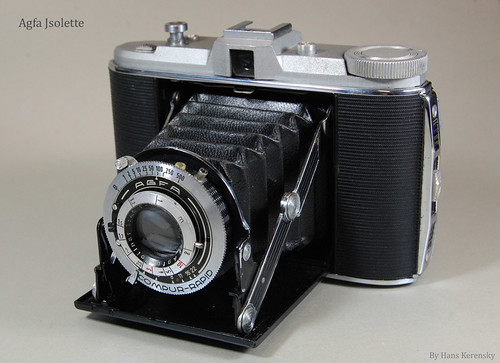
|
| Post-War Isolette image by Hans Kerensky (Image rights) |
The late model was made from 1945 till 1950. The top housing of this model is cast from Hydronalium (Nüral: an aluminium alloy). There were different lens/shutter combinations possible. Other changes from the early model are to one film format only (6x6) and the addition of an accessory shoe (above the viewfinder).
- Year of release: 1945
- Film Format: 12 exp. 6x6 on 120 film.
- Shutter: Prontor, Prontor-S or Compur-Rapid.
- Lens: Apotar 8.5cm f/4.5 or Solinar 8.5cm f/4.5.
- Double exposure prevention.
- Viewfinder: reverse-Galilean viewfinder
Succeeding models
After 1950, several different models of the Isolette were made at the same time, with different levels of specification:
- the Isolette I
- the Isolette II
- the Isolette III
- the Isolette V
- the Super Isolette
- the Isolette L
Notes
- ↑ The name is written as Jsolette simply because the capital "I" resembles a "J" in German typography of the time. The embossing on the camera was changed to a modern "I" in 1937. See: Old German Letters
- ↑ 2.0 2.1 McKeown, James M. and Joan C. McKeown's Price Guide to Antique and Classic Cameras, 12th Edition, 2005-2006. USA, Centennial Photo Service, 2004. ISBN 0-931838-40-1 (hardcover). ISBN 0-931838-41-X (softcover). p25.
